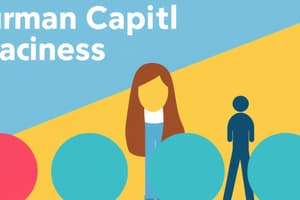Podcast
Questions and Answers
What is the primary goal of job design?
What is the primary goal of job design?
- To minimize employee responsibilities
- To regularly update job descriptions
- To create new job titles for employees
- To maximize job performance and satisfaction (correct)
Which method of job design involves adding activities within the same level to an existing role?
Which method of job design involves adding activities within the same level to an existing role?
- Job rotation
- Job enrichment
- Job enlargement (correct)
- Job substitution
What is the main advantage of internal recruitment?
What is the main advantage of internal recruitment?
- Lower risk in selecting candidates (correct)
- Exposure to new ideas and innovative strategies
- Higher costs associated with the process
- Access to a more diverse talent pool
What is a disadvantage of using online recruitment?
What is a disadvantage of using online recruitment?
What does a realistic job preview aim to provide to candidates?
What does a realistic job preview aim to provide to candidates?
Why is job enrichment considered a beneficial strategy in job design?
Why is job enrichment considered a beneficial strategy in job design?
Which of the following is not a strategy of job design?
Which of the following is not a strategy of job design?
What is the purpose of preliminary screening in the selection process?
What is the purpose of preliminary screening in the selection process?
What is typically an outcome of job rotation?
What is typically an outcome of job rotation?
What is one recognized disadvantage of campus recruitment?
What is one recognized disadvantage of campus recruitment?
What is the primary focus of reliability in selection testing?
What is the primary focus of reliability in selection testing?
Which type of validity assesses how well test scores relate to current performance?
Which type of validity assesses how well test scores relate to current performance?
What is a potential limitation of personality tests in selection processes?
What is a potential limitation of personality tests in selection processes?
The halo/horn effect in selection interviews can lead to what type of bias?
The halo/horn effect in selection interviews can lead to what type of bias?
In a compensatory model of selection, how are candidates evaluated?
In a compensatory model of selection, how are candidates evaluated?
What does construct validity include when assessing a test?
What does construct validity include when assessing a test?
Which step in the selection process involves verifying provided details about a candidate?
Which step in the selection process involves verifying provided details about a candidate?
What is a characteristic of cognitive ability tests in the selection process?
What is a characteristic of cognitive ability tests in the selection process?
Which selection method requires candidates to pass each test sequentially?
Which selection method requires candidates to pass each test sequentially?
What legal concern arises from negligent hiring?
What legal concern arises from negligent hiring?
What is the primary focus of human resource management (HRM)?
What is the primary focus of human resource management (HRM)?
Which of the following is NOT a characteristic of strategic goals in organizations?
Which of the following is NOT a characteristic of strategic goals in organizations?
How does corporate climate differ from corporate culture?
How does corporate climate differ from corporate culture?
What is emphasized in evidence-based HR practices?
What is emphasized in evidence-based HR practices?
Which form of discrimination involves a neutral policy that has an unintended negative effect?
Which form of discrimination involves a neutral policy that has an unintended negative effect?
What does the Meiorin Test establish regarding Bona Fide Occupational Requirements (BFOR)?
What does the Meiorin Test establish regarding Bona Fide Occupational Requirements (BFOR)?
Which step is NOT part of the job analysis process?
Which step is NOT part of the job analysis process?
What type of job analysis tool uses 195 standardized items about job elements?
What type of job analysis tool uses 195 standardized items about job elements?
Which of the following is a core category in competency modeling?
Which of the following is a core category in competency modeling?
What is the primary purpose of job analysis in the context of performance management?
What is the primary purpose of job analysis in the context of performance management?
What is the purpose of a job specification?
What is the purpose of a job specification?
What impact can good corporate culture have on an organization?
What impact can good corporate culture have on an organization?
Which of the following refers to the collection of related tasks and responsibilities defined as a job?
Which of the following refers to the collection of related tasks and responsibilities defined as a job?
What best defines a corporate climate?
What best defines a corporate climate?
Flashcards are hidden until you start studying
Study Notes
Unit 1: Human Resources and Management
- Human resources encompass individuals comprising an organization’s workforce.
- Human capital refers to the collective knowledge, skills, and expertise of employees, with investment in human capital resulting in stronger organizations.
Human Resource Management (HRM)
- HRM manages organizational staffing and encompasses both operational and strategic functions.
- Operational functions handle administrative daily tasks, while strategic functions aim to align employee performance with organizational goals.
- Strategic goals contribute to an organization’s competitive advantage through defined financial and non-financial results.
Corporate Culture and Climate
- Corporate culture is the identity of an organization, influenced by leadership and HR systems, promoting core values and behavioral standards.
- Corporate climate refers to the prevailing atmosphere or vibe within the organization, shaped by leadership style, communication, and HR policies, affecting employee mood and productivity.
Benefits of HRM
- Effective HRM reduces costs by improving retention and enhancing HR systems.
- Greater employee engagement fosters emotional commitment beyond job satisfaction.
- Improved overall performance resulting in higher employee output and increased profits.
Evidence-Based HR
- Involves evaluating HR practices through research to achieve efficiencies and desired outcomes.
- Various research methods include primary studies for new information and secondary studies for existing data.
Research Methodologies
- Variables: Independent (controlled) and dependent (measured).
- True Experiments: Conducted in controlled environments with random groups.
- Quasi Experiments: Conducted in natural settings, utilizing existing groups.
- Correlation: Examines relationships between variables; not all correlations are causal.
Legal Issues in HRM
- Charter of Rights and Freedoms (1982) ensures fundamental rights, emphasizing equality and anti-discrimination.
- Human Rights Legislation prohibits unfair treatment based on personal characteristics, applicable in both employment and commercial contexts.
- Bona Fide Occupational Requirements (BFOR) allow certain discriminatory practices justified by necessity, established through criteria like the Meiorin Test.
Unit 2: Job Analysis
- Job analysis is the ongoing process of collecting detailed information about job tasks and requirements.
- Clear job descriptors aid in training, performance management, fair compensation, and effective recruitment.
Job Analysis Steps
- Step 1: Review background info utilizing tools like the National Occupational Classification and organizational charts.
- Step 2: Choose sources of job information, including incumbents, supervisors, and job analysts for diverse perspectives.
- Step 3: Gather job information through questionnaires, interviews, and direct observation.
- Step 4: Develop pivotal documents such as job descriptions (tasks and responsibilities) and job specifications (required attributes).
Competency Modelling
- An alternative to traditional job analysis that emphasizes capabilities over job specificity.
- Categories include core competencies applicable organization-wide, cross-functional competencies specific to job groups, and functional competencies for particular roles.
Job Design
- Establishes roles and responsibilities, aiming to maximize job performance, efficiency, and satisfaction through methods like job rotation and job enrichment.
Unit 3: Job Acquisition
- Recruitment focuses on attracting candidates through job descriptions and specifications, ending with an applicant pool.
Recruitment Strategies
- Internal: Promotes existing employees but may maintain the status quo.
- External: Targets outside candidates via online platforms, print media, or campus recruitment; can attract wider talent but may also have risks.
Managing Recruitment Expectations
- Managing employee expectations includes establishing a favorable employer brand and providing realistic job previews to enhance retention.
Selection Process
- Step 1: Preliminary Screening involves reviewing applications and eliminating unsuitable candidates.
- Step 2: Selection Testing assesses qualities relevant to job analysis, ensuring reliability and validity.
Types of Tests
- Cognitive Ability: Measures intelligence and decision-making abilities.
- Personality Tests: Use traits to predict job performance via the Big Five Personality Model.
Selection Interview Process
- Multi-purpose interviews assess qualifications and promote the employer brand, though biases such as halo effects and similarity biases may affect outcomes.
Background Investigation
- Validates details from candidates’ applications and requires permission for checks on education, employment history, and references, as negligent hiring can lead to legal issues.
Selection Decision Models
- Multiple cut-off and compensatory models determine candidate selection based on performance across various assessments.
Studying That Suits You
Use AI to generate personalized quizzes and flashcards to suit your learning preferences.




